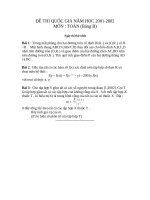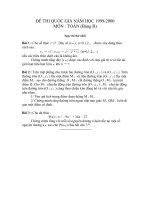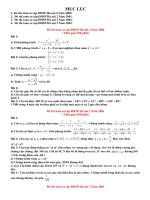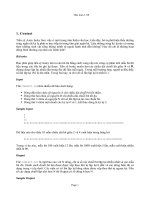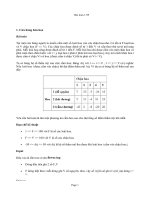Đề thi Toán quốc tế AMO năm 2017
Bạn đang xem bản rút gọn của tài liệu. Xem và tải ngay bản đầy đủ của tài liệu tại đây (233.2 KB, 4 trang )
<span class='text_page_counter'>(1)</span><div class='page_container' data-page=1>
2017 AUCKLAND MATHEMATICAL OLYMPIAD
<b>Questions, Solutions, and Grading suggestions </b>
<b>Junior Division </b>
<b>1. A 6 meter ladder rests against a vertical wall. The midpoint of the ladder is twice as far </b>
from the ground as it is from the wall.
At what height on the wall does the ladder reach? Simplify this as much as possible,
and explain your reasoning.
Soln.
Let x be the distance from the midpoint of the ladder to the wall.
Using congruent triangles and Pythagoras, 62 <sub>= (2𝑥𝑥)</sub>2<sub>+ (4𝑥𝑥)</sub>2<sub>, </sub><b><sub>[1 mk] </sub></b>
whence x = 3
√5 (1.34m) <b>[1 mk] </b>
So the desired height is 12
√5 (5.37m) <b>[1 mk] </b>
<b>2. Two players take turns to write natural numbers on a board. The rules forbid writing </b>
numbers greater than p and also divisors of previously written numbers. The player who
has no move loses.
Determine which player has a winning strategy for p = 10 and describe this strategy.
Soln.
The first person wins <b>[1 mk] </b>
by playing 6. <b>[1 mk] </b>
After that the only plays are 4, 5, 7, 8, 9, 10.
We group these numbers in pairs (4,5), (7,9) and (8,10). <b>[1 mk] </b>
It is clear that these give a reply to the subsequent plays of the second player.
<b>3. Three equal circles of radius r each pass through the centres of the other two. </b>
What is the area of intersection that is common to all the three circles?
Explain your reasoning.
Soln.
Let the centres of the circles be O1, O2, O3.
Let A be the area of the triangle ∆O1 O2 O3 and let S be the area of the sector of the
circle with centre O1 and bound by the points O2 and O3. <b>[1 mk] </b>
The desired area is A + 3(S - A) <b>[1 mk] </b>
= 3S - 2A
= 3 ×1<sub>6</sub>𝜋𝜋𝑟𝑟2<sub> − 2 ×</sub>1
4√3𝑟𝑟2
</div>
<span class='text_page_counter'>(2)</span><div class='page_container' data-page=2>
<b>4. The positive integers from 1 to n inclusive are written on a whiteboard. </b>
After one number is erased, the average (arithmetic mean) of the remaining n − 1
numbers is 22. Knowing that n is odd, determine n and the number that was erased.
Explain your reasoning.
Soln.
When we erase one number from 1,2,...,n, the minimum sum of the remaining numbers
is (𝑛𝑛−1)𝑛𝑛<sub>2</sub> , and the maximum sum is: 𝑛𝑛(𝑛𝑛+1)<sub>2</sub> − 1 = (𝑛𝑛+2)(𝑛𝑛−1)<sub>2</sub> <b>[1 mk] </b>
Hence the average of the remaining numbers lies between 𝑛𝑛<sub>2</sub> and (𝑛𝑛+2)<sub>2</sub> .
This gives 𝑛𝑛<sub>2</sub> ≤ 22 ≤ (𝑛𝑛+2)<sub>2</sub> , whence n = 42, 43 or 44.
Thus n=43. <b>[1 mk] </b>
Now 42 × 22 = 924 and the sum of all numbers from 1 to 43 is 946.
So the number erased is 22. <b>[1 mk] </b>
<i><b>5. A rectangle ABCD is given. On the side AB, n different points are chosen strictly between </b></i>
A and B. Similarly, <i>m different points are chosen on the side AD between </i>
A and D. Lines are drawn from the points parallel to the sides.
How many rectangles are formed in this way?
(An example of a particular rectangle ABCD is shown with a shaded one rectangle that
may be formed in this way).
Soln.
Note that a rectangle is uniquely determined by a pair of horizontal lines
and a pair of vertical lines. <b>[1 mk] </b>
Since there are 𝑚𝑚 + 2 horizontal lines and 𝑛𝑛 + 2 vertical lines (counting the sides),
<b>[1 mk] </b>
the number of rectangles is (m+2 choose 2) (n+2 choose 2) <b>[1 mk] </b>
= (𝑚𝑚+2)(𝑚𝑚+1)(𝑛𝑛+2)(𝑛𝑛+1).<sub>4</sub>
D C
B
A <i>n = 4 </i>
</div>
<span class='text_page_counter'>(3)</span><div class='page_container' data-page=3>
2
<b>Senior Division</b>
<b>1. </b> In an apartment block there live only couples of parents with children. It is known that
every couple has at least one child, that every child has exactly two parents, that every
little boy in this building has a sister, and that among the children there are more boys
than girls. You may also assume that there are no grandparents living in the building.
Is it possible that there are more parents than children in the building? Explain your
reasoning.
Soln<i>. </i>
Since every family has children, it follows that there is a girl in every family. <b>[1 mk] </b>
Hence there are at least as many daughters as there are mothers.
But there are more boys than girls. Hence there are more boys than fathers. <b><sub>[1 mk] </sub></b>
Therefore there are more children than adults. <b><sub>[1 mk]</sub></b>
<b>2. </b>The sum of the three nonnegative real numbers <i>x</i>1<i>, x</i>2<i>, x</i>3 is not greater than 1<sub>2</sub>.
Prove that (1 <i>− x</i>1)(1 <i>− x</i>2)(1 <i>− x</i>3) ≥ 1<sub>2</sub>
<i>Soln. </i>
Since <i>x</i>1 + <i>x</i>2 + <i>x</i>3 ≤ 1<sub>2</sub>
we get (1 <i>− x</i>1)(1 <i>− x</i>2)(1 <i>− x</i>3)
= 1 <i>− (x</i>1 + <i>x</i>2 + <i>x</i>3) + (<i>x</i>1<i>x</i>2 + <i>x</i>2<i>x</i>3 + <i>x</i>1<i>x</i>3) <i>− x</i>1<i>x</i>2<i>x</i>3 <b>[1 mk]</b>
≥ 1<sub>2</sub> + <i>x</i>1<i>x</i>2 + <i>x</i>1<i>x</i>3 + (1 <i>− x</i>1)<i>x</i>2<i>x</i>3 <b>[1 mk]</b>
≥ 1<sub>2</sub>
since 1 <i>− (x</i>1 + <i>x</i>2 + <i>x</i>3) ≥ 1<sub>2</sub>
and 1 <i>− x</i>1 <i>≥ 0. </i><b>[1 mk]</b>
<b>3. </b> The positive integer <i>N = 11 . . . 11, whose decimal representation contains only ones, </i>
is divisible by 7. Prove that this positive integer is also divisible by 13.
Soln.
We note that 7 · 13 = 91. <b>[1 mk]</b>
Since 7 · 13 · 11 = 91 · 11 = 1001, and N is divisible by 1001 if the number of digits
in <i>N is a multiple of 6. </i>
Otherwise, <i>N has remainder 1, 11, 111, or 1111 when divided by 111111. </i>
<b>[1 mk]</b>
</div>
<span class='text_page_counter'>(4)</span><div class='page_container' data-page=4>
<b>4. </b>There are 11 empty boxes and a pile of stones. Two players play the following game by
alternating moves: In one move a player takes 10 stones from the pile and places them
into boxes, taking care to place no more than one stone in any box. The winner is the
player after whose move there appear 21 stones in one of the boxes for the first time.
If a player wants to guarantee that they win the game, should they go first or second?
Explain your reasoning.
Soln.
(there could be many solutions here)
A move can be encoded by the number of the box where a stone is not placed.
Suppose 1 is the move of the first player. In the first 10 moves the second player
plays 2<i>, 3, . . . , 11. After these moves (we do not count 10 other moves of the first player </i>
yet) there will be 10 stones in each box.
Now let us add the stones put by those ten moves of player 1 which we did not count.
After these, at least in one of the boxes there will be 20 stones (Pigeonhole Principle).
Thus in the next move of the second player can be a winning one.
<i>Here there will be many solutions. I think the key here will be the realization that what is important is in </i>
<i>which box the stone is not placed and encode the move by the number of the respective box. </i><b>[1 mk]</b>.
<i>There may be some near misses which are worth another </i><b>[1 mk] </b>
Correct solution<b> [1 mk]</b>
<b>5. </b> The altitudes of triangle <i>ABC intersect at a point H. </i>
Find <i>∠ACB if it is known that AB = CH. </i>
Explain your reasoning.
Soln.
We observe that <i>∠ACF = ∠ABE. </i>
Since <i>AB = CH, we have ∠CHE = ∠EAB, </i><b>[1 mk] </b>
and, in particular, <i>AE = EH. </i><b>[1 mk]</b>
Since <i>∠AEH = 90◦ </i><sub>this means </sub><i><sub>∠EAH = 45</sub>◦</i>
Also <i>∠AGC = 90◦ </i><sub>inside ∆𝐴𝐴𝐴𝐴𝐴𝐴 </sub>
thus ∠ACB = 45<i>◦</i><sub>. </sub><b><sub>[1 mk]</sub></b>
</div>
<!--links-->

